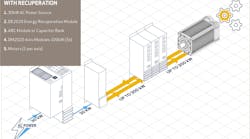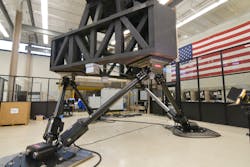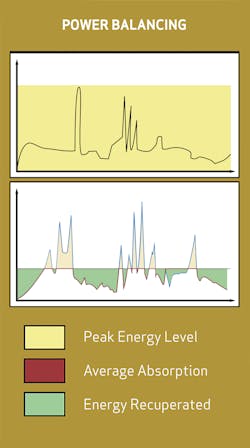Moog Inc. has introduced the Gen3 motion system which aids in training and certifying of commercial and military flight crews. The motion system can also facilitate motor vehicle development. In conjunction with the new motion system, Moog has also introduced the new DE2020 smart energy management system designed to reduce surge power by 65%.
Bruno Chiodi, engineering manager at Moog’s facility in Casella, Italy, says the goal in developing the DE2020 was to save energy while enhancing the efficiency of industrial machines. “By leveling energy consumption throughout the work cycle, the system allows operators to reduce consumption and, at the same time, minimize the overall footprint of the machine since Moog can size the system’s cabinet controls and grid interface to be much smaller than the peaks in the cycle would otherwise require,” he explains.
Energy Recovery Provides Efficiency Gains
To develop the new DE2020, Moog used inspiration from its work with Formula 1 race cars. This has included working with MIT on electrification for E-Formula 1. Through that work Chiodi says Moog became familiar with the concepts and guiding principles of Kinetic Energy Recovery Systems (KERS) which were applied to the DE2020.
KERS recover a vehicle’s kinetic energy during braking events and stores that energy for later use, often in a flywheel or batteries. This stored energy can then be used to help acceleration.
The DE2020 works in a similar manner, absorbing short-term energy bursts which occur during use of the Gen3 motion system. Energy is stored in the Gen3 motion base’s capacitor banks and used when necessary to meet peak load requirements.
Moog says this design eliminates the need to size electrical power to handle peak loads, helping to streamline cable design and power connections for the Gen3 motion system. It also helps to save energy and reduce costs.
Chiodi says that because the DE2020 constantly manages energy intake it safeguards industrial applications from power fluctuations or power losses which could cause damage or interfere with operation.
According to Moog, the DE2020 can also be used to compensate for fluctuations by using a pre-filter in combination with the capacitor bank. In the event of a sudden power failure, the DE2020 can supply the Gen3 system with enough energy to reach the safe return to home position as well.
Additional Application Benefits
Moog sees the DE2020 offering the potential to improver performance for various applications including industrial automation, test benches, handling and robotics.The DE2020 can be used any applications where it’s necessary to dissipate excess energy through dynamic braking resistors, says Chiodi. “As the gap widens between a baseline work cycle and its peak phases, the greater the potential is for saving energy,” he says. “For example, with metal forming, a high dynamic is crucial, so this is an excellent application for the DE2020.”
There is also the potential for the DE2020 to replace hydraulic and pneumatic systems at industrial facilities. Chiodi says electromechanical systems have better efficiency than the equivalent hydraulic and pneumatic ones, especially when considering the latter consume energy when idling. “If a machine owner were to replace a hydraulic system with an electromechanical one and then incorporate the DE2020, he or she would build on the electromechanical system’s inherent efficiency by also returning energy to the system that might otherwise be lost,” he concludes.




